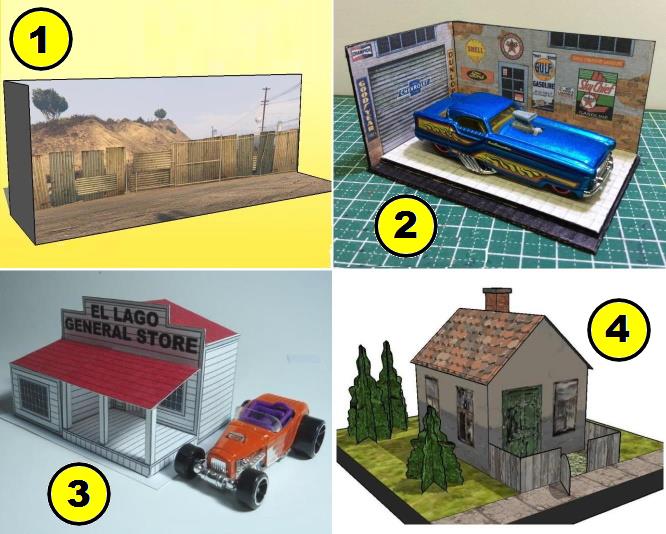This beautiful paper model in 1/32 scale of a 1956 Peterbilt 281 tank truck was created by Japanese designer and model maker Masahiro Kushima, from the Paper Model Studio website.
The model was clearly inspired by the iconic tank truck from "Duel", a thriller film directed by Steven Spielberg and released in 1971.
The plot is simple and ingenious: an ordinary man, a salesman named David Mann, is driving along a deserted road and becomes chased by a menacing driver who is never shown in the film.
The growing tension is notable thanks to Spielberg's ability to create suspense with limited resources.
The reason for the truck driver's fury against David is not explained at any point and if you search the internet you will see that there are several theories, the most common being one that argues that the truck driver is enraged by the fact that Mann overtook his vehicle, this being the cause of the entire escalation of violence, and another that maintains that the truck driver is a psychopath who takes the opportunity to terrorize Mann without a clear reason, just for the pleasure of exercising power and control over another person.
I watched this film when I was six or seven years old, I think, in the early hours of the morning on a free-to-air TV channel (well, there were only free-to-air TV channels when I was a kid in the 1970s) and I remember being very impressed by the story. and, even though I didn't understand anything about cinema, I knew I had seen something special.
After many years, as a teenager and with the advent of videocassettes, I watched this film again and found out that it was by Spielberg.
"Duel" is often considered Steven Spielberg's first feature film, even though it was technically made for television rather than theaters.
The film was originally broadcast as a "Movie of the Week" on the ABC television network on November 13, 1971. Due to its success, an extended version was released theatrically in some countries.
Well, back to papercraft, Mr. Kushima is publishing this model in parts. Today we have the first part that is made up of the truck body. The wheels and tank will come in the next few days or weeks.
To reinforce the film's atmosphere, Mr. Kushima will also publish David Mann's car in the future, the red Chrysler Plymouth Valiant, in the same scale as the Peterbilt 281.
Este belíssimo modelo de papel na escala 1/32 de um caminhão tanque Peterbilt 281 de 1956 foi criado pelo designer e modelista japonês Masahiro Kushima, do site Paper Model Studio.
O modelo foi claramente inspirado no icônico caminhão tanque de "Duel", filme de suspense dirigido por Steven Spielberg e lançado em 1971.
A trama é simples e genial: um homem comum, um vendedor chamado David Mann, está dirigindo por uma estrada deserta e passa a ser perseguido por um caminhão-tanque dirigido por um motorista ameaçador que nunca é mostrado no filme.
É notável a tensão crescente graças a habilidade de Spielberg em criar suspense com recursos limitados.
O motivo da fúria do caminhoneiro contra David não é explicada em nenhum momento e se você pesquisar na internet vai ver que há várias teorias, sendo as mais comuns uma que argumenta que o motorista do caminhão fica enfurecido pelo fato de Mann ter ultrapassado seu veículo, sendo essa a causa de toda a escalada de violência, e outra que sustenta que o caminhoneiro é um psicopata que aproveita a oportunidade para aterrorizar Mann sem um motivo claro, apenas pelo prazer de exercer poder e controle sobre outra pessoa.
Eu assisti esse filme quando eu tinha seis ou sete anos, acho eu, de madrugada em um canal de tv aberta (bem, só haviam canais de tv aberta quando eu era criança na década de 1970) e lembro que fiquei muito impressionado com a história e, mesmo sem entender nada de cinema, eu sabia que havia visto algo especial.
Depois de muitos anos, já na adolescência e com o advento dos videocassetes, eu voltei a assistir esse filme e saber que era de Spielberg.
"Duel" é frequentemente considerado o primeiro longa-metragem de Steven Spielberg, embora tecnicamente tenha sido feito para a televisão e não para os cinemas.
O filme foi originalmente transmitido como um "Movie of the Week" na rede de televisão ABC em 13 de novembro de 1971. Devido ao seu sucesso, uma versão estendida foi lançada nos cinemas em alguns países.
Bem, voltando ao papercraft, o Sr. Kushima está publicando este modelo em partes. Hoje temos a primeira parte que é composta da carroceria do caminhão. As rodas e o tanque virão nos próximos dias ou semanas.
Para reforçar o clima do filme, o Sr. Kushima também publicará futuramente o carro de David Mann, o Chrysler Plymouth Valiant vermelho, na mesma escala do Peterbilt 281.































